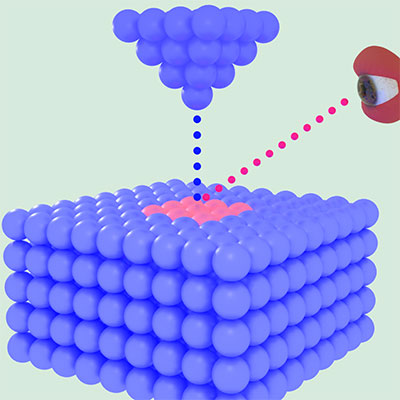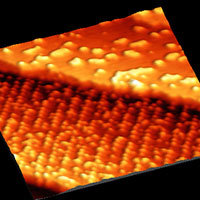Scanning tunnelling microscope for magnetic atoms
Philosophers in ancient Greece already believed that matter is made up of atoms. Only about 35 years ago, however, were atoms actually observed for the first time – in Zurich. The scanning tunnelling microscope developed by Gerd Binnig and Heinrich Rohrer allowed surfaces of materials to be investigated with a spatial resolution of less than one nanometre – enough to see individual atoms.
A team of researchers led by Urs Ramsperger and Danilo Pescia at the Laboratory for Solid State Physics of the ETH Zurich, together with a colleague at Istanbul Technical University, have now added a crucial detail to the capabilities of such extreme-resolution microscopes.
As reported in the journal Scientific Reports, they succeeded in measuring the magnetisation of a material with a spatial resolution of a few nanometres. In the future, this technology could be used for the magnetic imaging of materials as well as for the development of novel methods in information processing.
The main peculiarity of the new technology is that, actually, it shouldn’t work at all. To resolve individual atoms, a scanning tunnelling microscope uses a metal tip that is put extremely close to the surface of a material, in fact to within the size of an atom (smaller than one nanometre).

According to the rules of quantum mechanics, at such short distances electrons can tunnel from the metal tip into the material and thus create an electric current that can be used to create an image of the surface. The researchers at ETH now increased that distance to several nanometres and were doubly surprised, as Danilo Pescia explains:
“On the one hand, despite the larger distance we still had very good spatial resolution, and on the other hand we were able to extract electrons from the tunnel region – although calculations had shown that extraction should be practically impossible.”
Normally electrons tunnelling from the metal tip into the material, even at tip-surface separations of a few nanometres, are trapped in the gap in between and, according to theory, should leave the tunnel region only very rarely.
The extracted electrons, however, contain valuable information. Their spin is particularly interesting to the researchers, as it tells them whether and in which direction the atoms of the material under investigation are magnetised.
The spin designates an inner rotation of the electrons, but in practice only leads to a very small measurable signal. Detecting it is, therefore, a big technical challenge, particularly under the difficult conditions of a tunnelling experiment.
In their experiment, the scientists applied a suitable voltage to the metal tip of a scanning tunnelling microscope that caused electrons without a particular spin direction to be ejected. When they encountered magnetic atoms – atoms, that is, that have a well-defined spin – the spin direction of the atoms was transferred to the electrons extracted from the tunnel region.

The spin direction of the extracted electrons was finally measured, using a spin detector. In this way, it was possible to detect the magnetisation of the material with a spatial resolution of five nanometres.
Already around thirty years ago, a similar experiment was attempted both at IBM Zurich and at the National Institute of Standards and Technology in the USA. The goal of obtaining a spatially resolved image of the magnetic state, however, was not achieved.
The researchers at ETH are satisfied that they now succeeded in spite of the negative predictions. Currently they are trying to understand their unexpected success theoretically, too, and also to push the limits of the newly developed technology.
In the USA there is also a renewed interest in instruments similar to the one now built at ETH, and the National Science foundation provides generous funding for related projects.
For Urs Ramsperger and Danilo Pescia, there is a clear lesson to be learned from this story: “In research one mustn’t be afraid of trying the impossible once in a while”, they say and add: “Sometimes things work better in practice than in theory – after all, paper is just paper.”
Their courage has now been rewarded and will, the researchers hope, lead to various applications. For instance, the magnetic properties of materials could be studied in real time with a resolution of a trillionth of a second.
As the current experiment effectively converted an electric voltage into a spin (which makes it an example of modern “spintronics”), the controlled manipulation of the magnetisation of individual atoms should also be possible.










